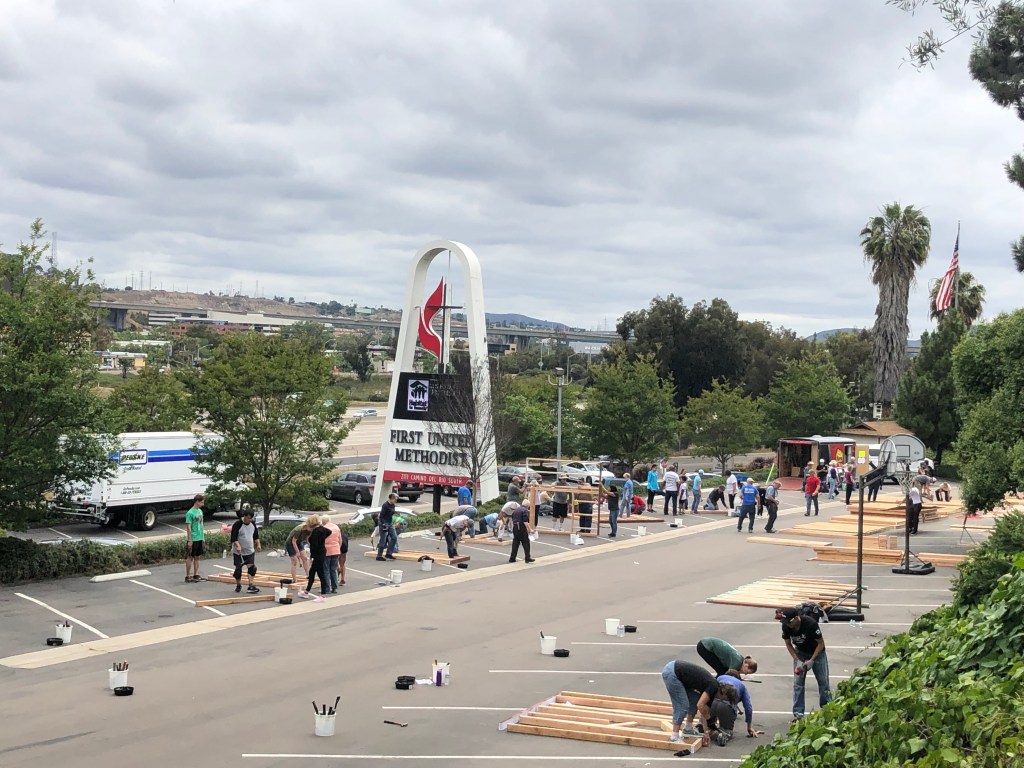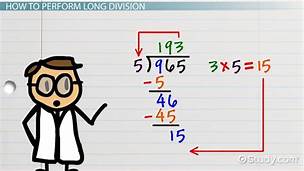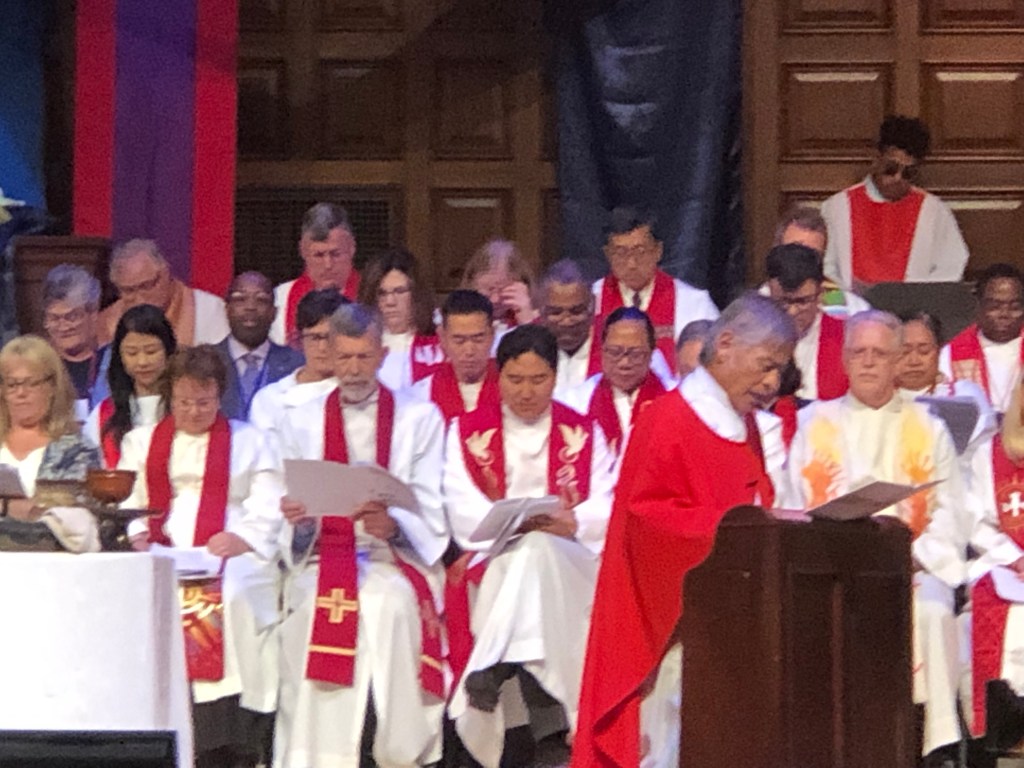
United Methodism’s Long Division Problem
My daily morning dyspepsia is, I believe, related to long division problems. I am awake in the early morning, unable to find rest amid puzzles I can’t seem to solve. At about age eight, a teacher taught me “to do long division.” The moment was delicious — I could solve big numbers that before seemed too large. In my early teens, I discovered algebraic long division. Another revelation, a gift, a tool.
Today, my morning dyspepsia, is not so simple. This problem requires an institutional calculus. It is not division I seek: rather, it is the seeking ways to avoid so much dividing — it is greater unity I would like to cipher. Every theological and social instinct within me calls out for linkage, for connection, for common ground rather than a land of separation. Am I simply foolish, nostalgic, tied to some ancient vision of St. Francis bargaining with the wolf or his meeting with the enemies during the Crusades to discover ways of peace?
Why is our nation so tribal, so insistent on becoming a splintering galaxy of spinning ideological enclaves? In ways I suspect most of us don’t fully see, the corollary exists in the divisions of the United Methodist Church. Both nation and church are pursuing long division problems. They are here now, in part because in both nation and church, we have been on a path too long-dividing. Many forces and fractions have brought us to this point: the rise of social media and loss of common language; new cultural and economic ecologies where unemployment and poor community resources persist; much focus on personal and social grievance; churches that avoid their prophetic voice as they fear the loss of market share and numerical decline — all these additives, and more, have brought us to this whirlpool of distrust.
Let’s focus on United Methodism. Maybe if we untangle this a bit, or at least untie some of these knots, it will assist with other riddles. Hardly a week goes by that someone doesn’t ask for a division solution. It often happens like this – I am walking through fellowship hall at church and someone says, “What are we going to do?” I know what is meant but can’t help myself, I reply, “About what?” The answers are: “About the church.” “About the harm being done to LGBTQI persons.” “About damage to the United Methodist brand. ” “About the loss of our children who already think the church is out of touch with their worlds.” Or, I am entering a store downtown, a friend greets me and says, “What do you think is going to happen?” I play out the scene again. “About what?” I respond and I hear the same list of concerns.
Or, I get phone calls from friends around the country. (And, yes, I sometimes call them.) “What’s the latest you have heard?” “Which plan should we support?”
Add this to the daily news about presidential impeachments or government conspiracy and the result is dyspepsia along with a certain emotional and spiritual vertigo — right?

So, here are some thoughts about our long division problem in the church — these are a collection of hunches, perceptions, experiences, frequent early morning musings based on my faith journey and desire to be a follower of Jesus. Please note, these are not a plan, nor the son of a plan — no long division solution here. In fact, the PLANS I have seen are, to my mind, part of the problem. I almost chuckle at the plan of the week unveiled from some official or unofficial grouping of problem-solvers and I weep at the theological vacuity often evidenced.
I wonder if there aren’t several million plans out there among United Methodists around the world — one plan for each of the members of the denomination. Individualism and self-centered privilege lead us to find our corner with the like minded. We can shape things along with our gang and the lines of our personal preference. I think of Thomas Jefferson who in a letter to Ezra Stiles Ely on June 25, 1819 wrote: “You say you are a Calvinist. I am not. I am of a sect by myself, as far as I know.” My memory is that on another occasion Jefferson opined that he “carried his religious denomination under his hat.“
Well-meaning people (and some not so well-meaning) offer up new plans weekly. Some would divide the church into two groups, some three, some four. I have even heard of a plan for seven new denominations. At the same time I hear little of how these plans correspond with the great ecumenical prayer of Jesus that “they would be one” (John 17) or the message from Paul about the church as a body with many members (I Corinthians 12).
Most of the proposals that are trumpeted seem unaware of the lessons of church history or from Christians of other denominational families who have struggled with divisions in recent years. What might we learn from the Cooperative Baptist Fellowship that still speaks, five decades later, of “Forming Together” after the splintering of Southern Baptists? What lessons might our Pan Methodist friends teach us as some large congregations have split off from their fellowships? Or, what of the Lutherans, the Seminex story from the Missouri Synod Church, or the merger resulting in the ELCA (Evangelical Lutheran Church in America) and the challenges they have faced? What lessons from the Assembly of God and splintering there? The Wesleyan Church? What might we learn from the United or Uniting Churches around the world (India, Canada, etc.) Or, what of lessons from our older sibling, the Episcopal Church.
Rather than a plan, I would offer some paradoxical thoughts, some ecclesiological assumptions, some prayerful hints for how we might proceed… with or without a plan. Paradoxical, yes, I propose them as cruciform. For they are. One clear assertion I will make is this: there will be no resurrection for us, no renewal apart from the cross. (In the gospels of Mark, Luke and Matthew there are the words like these “Those who try to gain their own life will lose it; but those who lose their life for my sake… you will find it..) Here are seven paradoxes to explore.
I pray that any reshaping or re-imagining of the United Methodist Church will be: Centered in the Christ of scripture and Christ alive in our world today; shaped by prayer and a humble mystic spirit; a seeking of unity among all believers even as we resist efforts to harm; focused locally as essential to a global witness; open to the long-haul of history in order to be relevant today; ready for sacrifice in order to find abundance in unexpected places; and, opening our hearts to the story of others within and beyond our daily routines so as to sharpen our Wesleyan distinctives.

When have I seen us at our best? Not when we are arguing or devising our long division plans but rather when we are in mission with others. I see it when the gospel is shared and persons and communities are changed. I see it when bishops pray and invite all, especially those who disagree to a common table. When those who join that table represent the extraordinary array of those from multiple cultures and classes modeling together an invitation to live in our time and place in terms of God’s emerging kin-dom.

I see it in the thousands of places where our actions speak louder than our words. Where the “theology of the hammer” brings people together. I see it when the church works along the Mexican border and says in the name of Jesus, we will welcome these who are in need of sanctuary and we will not bear false witness against them. I see it when the church takes seriously its commitment to care for all creation.

I see it when I meet another United Methodist, from Africa, Zimbabwe. He tells me his name is “Blessing” and we laugh together when we talk about our mutual friends. Yes, he had taken some classes at Africa University. Yes, he was a student there when I visited that campus. We join in conversation about how we might heal a broken church, in order to set about healing a broken world. It is in surprises like this that my dyspepsia finds relief.


Hi Phil, thank you. I teach World Religions at the community college. I use Huston Smith’s “The World’s Religions” and he describes the Protestant Principle in the Christianity section. I had never heard of it. But it resonates with me. God’s revelation is unfolding so we must beware of certitude in our theological understanding. I have come to believe it is certitude that divides us, but that certitude is really only professed on the fringes of our dialog. Unfortunately those professions are often the loudest and most organized. Peace and blessings to you. Ron
LikeLike
Thanks for this, Ron. As you might suspect, there were several sources that informed what I wrote. Most central were Parker Palmer’s “The Promise of Paradox” and Dietrich Bonhoeffer’s “Christ the Center.” Both were read long ago by this old man and both have stayed with me and, I hope, allowed space to welcome new faith understandings. Be well, brother. P
LikeLiked by 1 person
Thoughts to embrace.
Thank you.
Bonnie
LikeLike
Thank you, my friend, for this insightful and challenging reflection!
LikeLike
A great post!! Thoughtful. And Challenging!
>
LikeLike